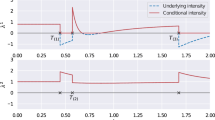Abstract
Mining temporal network models from discrete event streams is an important problem with applications in computational neuroscience, physical plant diagnostics, and human–computer interaction modeling. In this paper, we introduce the notion of excitatory networks which are essentially temporal models where all connections are stimulative, rather than inhibitive. The emphasis on excitatory connections facilitates learning of network models by creating bridges to frequent episode mining. Specifically, we show that frequent episodes help identify nodes with high mutual information relationships and that such relationships can be summarized into a dynamic Bayesian network (DBN). This leads to an algorithm that is significantly faster than state-of-the-art methods for inferring DBNs, while simultaneously providing theoretical guarantees on network optimality. We demonstrate the advantages of our approach through an application in neuroscience, where we show how strong excitatory networks can be efficiently inferred from both mathematical models of spiking neurons and several real neuroscience datasets.
Similar content being viewed by others
References
Bromberg F, Margaritis D, Honavar V (2009) Efficient markov network structure discovery using independence tests. J Artif Int Res 35(1): 449–484
Chickering DM (2003) Optimal structure identification with greedy search. J Mach Learn Res 3: 507–554
Chow C, Liu C (1968) Approximating discrete probability distributions with dependence trees. IEEE Trans Inf Theory 14(3): 462–467
Cooper GF, Herskovits E (1992) A bayesian method for the induction of probabilistic networks from data. Mach Learn 9: 309–347
Czanner G, Eden UT, Wirth S, Yanike M, Suzuki WA, Brown EN (2008) Analysis of between-trial and within-trial neural spiking dynamics. J Neurophysiol 99(5): 2672–2693
Eldawlatly S, Zhou Y, Jin R, Oweiss KG (2010) On the use of dynamic bayesian networks in reconstructing functional neuronal networks from spike train ensembles. Neural Comput 22(1): 158–189
Friedman N, Murphy K, Russell S (1998) Learning the structure of dynamic probabilistic networks. In: Proceedings of the UAI’98. Morgan Kaufmann, pp 139–147
Friedman N, Nachman I, Pe’er D (1999) Learning bayesian network structure from massive datasets: the “Sparse Candidate” algorithm. In: 5th conference on uncertainty in artificial intelligence UAI (1999). pp 206–215
Izhikevich EM (2006) Polychronization: computation with spikes. Neural Comput 18(2): 245–282
Jordan, MI (ed) (1998) Learning in graphical models. MIT Press, Cambridge
Laxman S (2006) Discovering frequent episodes: fast algorithms, Connections with HMMs and generalizations. PhD thesis, IISc, Bangalore, India
Laxman S, Sastry PS, Unnikrishnan KP (2005) Discovering frequent episodes and learning hidden markov models: a formal connection. IEEE TKDE 17(11): 1505–1517
Mannila H, Toivonen H, Verkamo A (1997) Discovery of frequent episodes in event sequences. Data Min Knowl Discov 1(3): 259–289
Meila M (1999) An accelerated chow and liu algorithm: fitting tree distributions to high-dimensional sparse data. In: Proceedings of the ICML’99. pp 249–257
Murphy K (2002) Dynamic Bayesian Networks: representation, inference and learning. PhD thesis, University of California, Berkeley, CA, USA
Papapetrou P et al (2009) Mining frequent arrangements of temporal intervals. Knowl Inf Syst 21(2): 133–171
Patnaik D, Sastry PS, Unnikrishnan KP (2007) Inferring neuronal network connectivity from spike data: a temporal data mining approach. Sci Program 16(1): 49–77
Pavlov D, Mannila H, Smyth P (2003) Beyond independence: probabilistic models for query approximation on binary transaction data. IEEE TKDE 15(6): 1409–1421
Raajay V (2009) Frequent episode mining and multi-neuronal spike train data analysis. Master’s thesis, IISc, Bangalore
Rieke F, Warland D, Steveninck R, Bialek W (1999) Spikes: exploring the neural code. MIT Press, Cambridge
Sastry PS, Unnikrishnan KP (2010) Conditional probability based significance tests for sequential patterns in multi-neuronal spike trains. Neural Comput 22(2): 1025–1059
Seppanen JK (2006) Using and extending itemsets in data mining: query approximation, dense itemsets and tiles. PhD thesis, Helsinki University of Technology
Sprekeler H, Michaelis C, Wiskott L (2007) Slowness: an objective for spike-timing-dependent plasticity? PLoS Comput Biol 3(6):e112. doi:10.1371/journal.pcbi.0030112
Takahashi N et al (2007) Watching neuronal circuit dynamics through functional multineuron calcium imaging (fmci). Neurosci Res 58(3): 219–225
Wagenaar DA, Pine J, Potter SM (2006) An extremely rich repertoire of bursting patterns during the development of cortical cultures. BMC Neurosci 7(1): 11 doi:10.1186/1471-2202-7-11
Wang C, Parthasarathy S (2006) Summarizing itemset patterns using probabilistic models. In: Proceedings of the KDD’06. ACM, New York, NY, USA, pp 730–735
Wang K, Zhang J, Shen F, Shi L (2008) Adaptive learning of dynamic bayesian networks with changing structures by detecting geometric structures of time series. Knowl Inf Syst 17(1): 121–133
Wang T, Yang J (2010) A heuristic method for learning bayesian networks using discrete particle swarm optimization. Knowl Inf Syst 24(2): 269–281 doi:10.1007/s10115-009-0239-6
Williamson J (2000) Approximating discrete probability distributions with bayesian networks. In: Proceedings of the international conference on AI in science & technology, Tasmania. pp 16–20
Author information
Authors and Affiliations
Corresponding author
Rights and permissions
About this article
Cite this article
Patnaik, D., Laxman, S. & Ramakrishnan, N. Discovering excitatory relationships using dynamic Bayesian networks. Knowl Inf Syst 29, 273–303 (2011). https://doi.org/10.1007/s10115-010-0344-6
Received:
Revised:
Accepted:
Published:
Issue Date:
DOI: https://doi.org/10.1007/s10115-010-0344-6




